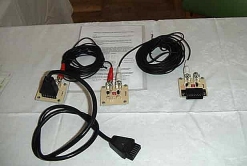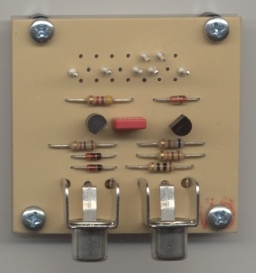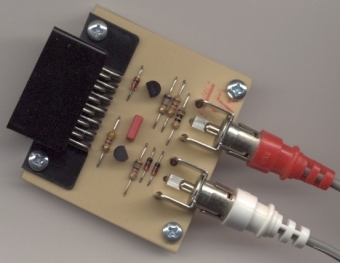Hello guys, this is my
first article for MyAtari magazine. Subject is a peripheral
that is able to connect two or more Atari 8-bit computers
for data exchange. This network interface is plugged
via a SIO cable (standard cable for the Atari 8-bit
computer's serial data bus) to the computer. A simple
two-way cable provides the connection to the other interfaces,
which are connected as a bus. I don't think there was
a device like that produced by Atari itself and I haven't
seen something like it anywhere else.
The Atari 8-bit network interface
was Jiri Bernasek's idea. He is Czech and I know him
only from articles he published in the ABBUC magazines.
Last year he wrote about a network game programmed by
himself. He used the hardware already working with an
older game to connect the computers. He drew a circuit
diagram of the network interface so anyone could build
the hardware at home. But until the annual general meeting
of the ABBUC club in 2000 there were no new built units
available.
Fortunately someone borrowed Jiri's
complete personal set of interfaces for the Unconventional
2000. We installed it on four computer systems so we
could play his game at the ABBUC club meeting. Some
people wanted to have such an interface but nobody was
selling it. I looked at the little piece of hardware
and thought it would not be difficult to build it even
in a bigger quantity. Later I discussed it with my friends
and then decided to construct the hardware (based on
Jiri's schematics) and distribute it like the other
hardware of the RAF. I requested and received the written
permission of Jiri to do this.
Additionally I thought, if the hardware
is available this will be a base for more software development.
Now we plan to start a programming competition in the
club and I hope people will create something. Perhaps
it can become a standard for networking with 8-bit Ataris.
Although I am manufacturing and distributing
the interface, I haven't written any software for it.
I don't know the software routines for handling the
data on the network, they should be requested from Jiri.
The game Jiri wrote is called Multi
Dash and it is freeware. It could be described as a
kind of multi-player Boulder Dash. Up to eight players
can collect gems, stones and bombs. The bombs are good
for blowing up walls or destroying other players. Collected
items and certain actions score points. There are also
computer-controlled opponents who can kill you or other
players. The one surviving the longest time and gathering
most points will win.
One of the computers acts as the server.
It loads the program from disk and all the other computers
boot via the network, so only one disk needed. There
is also the option to send messages from one system
to the others. The program is on the ABBUC Special Magazine
Disk #27 and includes a circuit diagram of the hardware
and a description of how to use it. At the Atariada
2000 in Prostejov (Czech Republic) it was presented
the first time. Later at the Unconventional 2000 in
Lengenfeld (Germany) with Jiri himself, at the ABBUC
annual general meeting 2000 in Herten (Germany) where
it won the 1st prize at the BOS (Best of Show) event
and finally at the Atari 8-bit fair in Schreiersgrün
(Germany) together with the new hardware of 2001 by
the RAF.
The program Maze of Agdagon is on
ABBUC Magazine Disk #50. This game is a 3D labyrinth
game for up to eight players. Like Multi Dash you have
to collect items and destroy other players with bombs.
The most important thing is to survive. The program
is written by the guys of the Agdagon Group, USA. It
is shareware and was published in 1993. It was presented
with the earlier network interface hardware at the Atariada
1999 in Prostejov (Czech Republic) and later in 2001
at the Atari 8-bit fair with the new hardware.
The interface circuit is quite simple.
The two separate signals from the SIO bus are joined
together by transistor stages to a single data line.
So it is possible to use a simple cable to get the computers
connected. A shielded cable is recommended, a coaxial
type will be the best. It works with a cable length
of up to 20 meters. The protocol of the data transfer
has to take in account that there can only be one transmitter
at a time on the line.

In February this year I started to
design the layout of the PCB (printed circuit board)
for the network interface. For this I used professional
CAD software to get the wires, connectors and components
onto a small board. Its dimensions are about 50 x 50
mm (2 x 2 inches). For the network media I chose cinch
cables (cable with RCA connectors) as they are commonly
used in the audio world, and that's one of my favourite
hobbies.
The SIO connectors have become rare
and expensive. Therefore I used single metallic pins
soldered on the board to make the connection to a SIO-cable
(every user should own one). But also it is possible
to assemble a SIO connector (male) on the board instead
of the pins. This is better but has its price.


I produce the interfaces by myself.
Cutting, drilling and assembling of the boards is completely
manual. Altogether it takes several hours to build one
interface. I haven't found a suitable case for them,
so they only get a protection plate on the solder side.
All those extras increase the price. So I offer as standard
a simple version. If someone wants a SIO connector,
a case or other extras I can build it to order.
Maybe I will offer a complete kit
for hobbyists later, with a lower price. Certainly every
interface will be tested. All the ones I manufactured
worked first-time.
In March I showed the first interfaces
to my friends at the RAF. We decided to present them
at the Atari 8-bit spring fair in Schreiersgrün
(Germany) at the end of the month. By this time I had
built eight interfaces and I could sell them all there.
This was a successful debut of the new hardware.
The price for one network interface
is 10 Euro (standard version). The cinch cable is extra
and costs 1 Euro (5 meters) or 2 Euro (10 meters). The
package and shipping is extra and depends on type of
payment, size and location. Order can be done via e-mail
or internet.
Author
profile
 My name sounds very English but
I am German. I have been a member of the
computer club ABBUC e.V. (ATARI Bit Byter
User Club, Germany) for more than two years
and I've visited Atari fairs in Germany
for many years. With three other freaks
I founded the RAF. No, it is not the Royal
Air Force, it is the Regional ABBUC group
Frankfurt/Main. My name sounds very English but
I am German. I have been a member of the
computer club ABBUC e.V. (ATARI Bit Byter
User Club, Germany) for more than two years
and I've visited Atari fairs in Germany
for many years. With three other freaks
I founded the RAF. No, it is not the Royal
Air Force, it is the Regional ABBUC group
Frankfurt/Main.
We have created some other
hardware and software mostly for the Atari
8-bit. You can have a look on our website.
My profession is electrical engineering
and I work in a company that develops and
produces equipment for aircraft. |
|